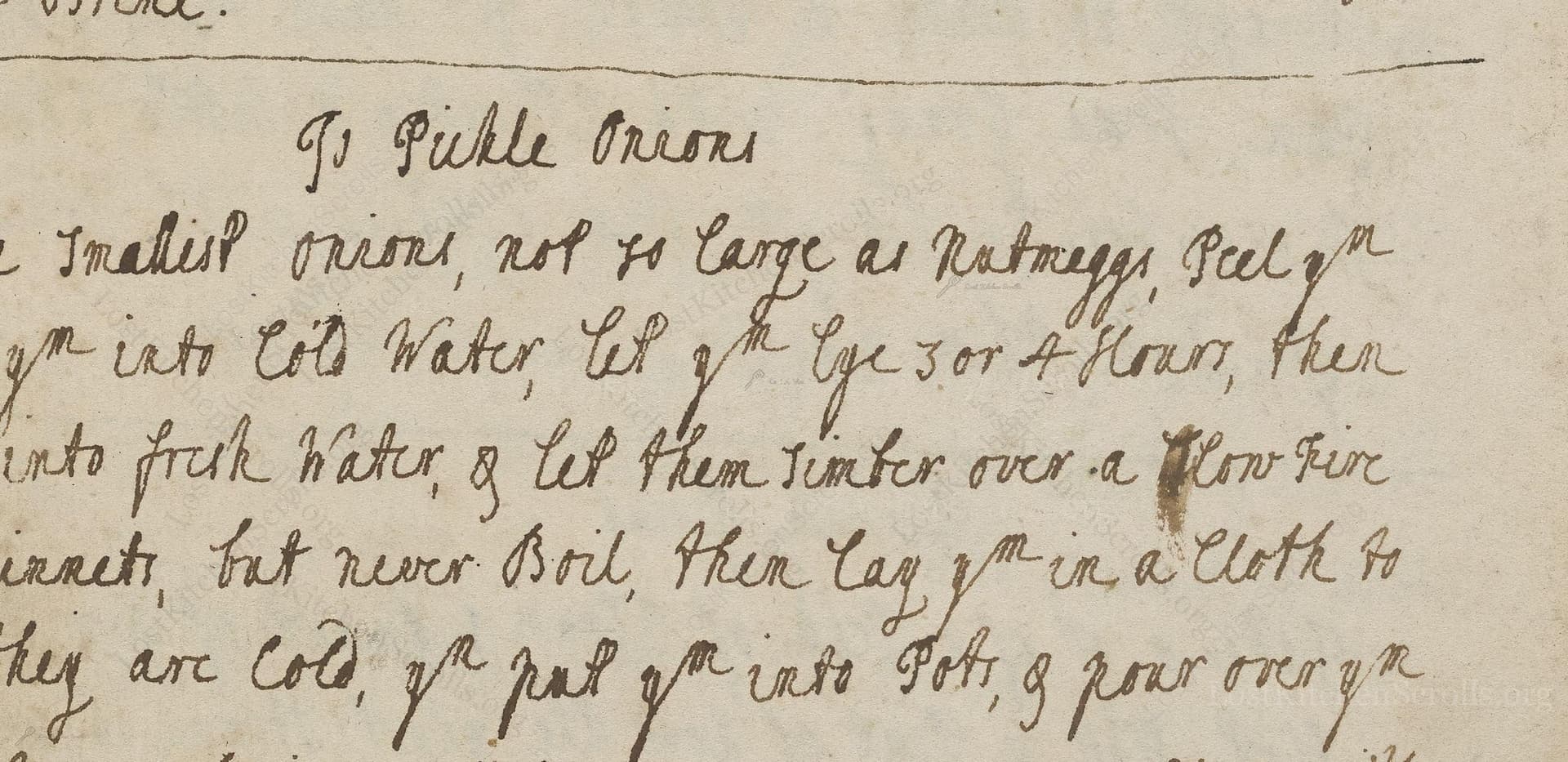To Pickle Onions
From the treasured pages of Receipt book of Elizabeth Smith
Written by Elizabeth Smith

To Pickle Onions
"Take the smallest onions, not so large as Nutmegs, Peel ym, & throw ym into Cold Water, let ym Lye 3 or 4 Houre, then put ym into fresh Water, & let them simber over a slow fire 10 or 15 minnutt, but never Boil, then lay ym in a Cloth to Dry till they are Cold, & put ym into Potts, & pour over ym Distiled Vinegar Boiling Hott, & tye ym down very Close with Paper & Leather, & keep ym for use."
Note on the Original Text
This recipe is written in the casual yet directive vernacular of the 18th century, with spelling (“ym” for 'them', “minnutt” for 'minute') reflecting phonetic norms of the time. Measurement was approximate, as precise scales were rare in domestic kitchens—hence directions like 'not so large as Nutmegs' and general time instructions. Such recipes assumed a foundational base of culinary knowledge passed orally or through practice, which allowed for missing details like specific quantities or temperatures.

Title
Receipt book of Elizabeth Smith (1775)
You can also click the book image above to peruse the original tome
Writer
Elizabeth Smith
Era
1775
Publisher
Unknown
Background
Step into the refined kitchens of the late 18th century with Elizabeth Smith, whose culinary wisdom offers a charming taste of Georgian elegance and time-honored recipes to delight any palate.
Kindly made available by
Folger Shakespeare Library
Elizabeth Smith’s recipe, penned in the late Georgian era (c. 1749–1800), reflects the period’s growing enthusiasm for preserving produce, particularly as imported spices and strong vinegars became widely available. Pickled onions were a staple in British households, gracing the tables as both garnish and accompaniment for hearty meats and cheeses. Recipes from this period were transmitted largely within households and regional communities, often passing from mother to daughter, and capture both the flavors and frugality of the age.

The recipe would have been made with basic kitchen implements typical to an 18th-century English home: a large basin for soaking and blanching, a wooden spoon for stirring, a slotted spoon for removing onions, thick cloths for drying, ceramic or glass jars (potts) for storage, and sturdy paper and leather ties for sealing the jars tightly against spoilage.
Prep Time
3 hrs 20 mins
Cook Time
20 mins
Servings
6
We've done our best to adapt this historical recipe for modern kitchens, but some details may still need refinement. We warmly welcome feedback from fellow cooks and culinary historians — your insights support the entire community!
Ingredients
- 1 lb 2 oz pearl onions (or shallots as substitute, if pearl onions unavailable)
- 4 1/4 cups cold water (for soaking and blanching)
- 3 1/8 cups distilled white vinegar
Instructions
- To make pickled onions as described in Elizabeth Smith's late 18th-century recipe, start by selecting small, pearl onions (ideally about the size of a nutmeg, roughly 3/4–1 1/4 inches in diameter).
- Peel them and place them in cold water for 3–4 hours.
- Drain, then refresh with new cold water.
- Gently heat the onions in this water over low heat for 10–15 minutes, ensuring the water is just shy of boiling—they should not fully cook or break apart.
- Remove the onions and let them drain and dry on a clean kitchen towel until completely cool.
- Pack the cooled onions into sterilized glass jars.
- Heat distilled white vinegar to a vigorous boil, then immediately pour the hot vinegar over the onions until they are completely submerged.
- Seal the jars tightly and store in a cool, dark place.
- The pickled onions can be enjoyed after several days and will keep for several months.
Estimated Calories
30 per serving
Cooking Estimates
You will spend about 20 minutes preparing the onions and jars, plus at least 3 hours soaking the onions. Cooking time is about 10-15 minutes to gently heat the onions (not boil), and a few more minutes to boil the vinegar and pour it over the onions. This recipe yields about 6 servings, with each serving estimated at roughly 30 calories, mainly from the onions, since vinegar adds almost no calories.
As noted above, we have made our best effort to translate and adapt this historical recipe for modern kitchens, taking into account ingredients nowadays, cooking techniques, measurements, and so on. However, historical recipes often contain assumptions that require interpretation.
We'd love for anyone to help improve these adaptations. Community contributions are highly welcome. If you have suggestions, corrections, or cooking tips based on your experience with this recipe, please share them below.
Join the Discussion
Rate This Recipe
Dietary Preference
Main Ingredients
Occasions

Den Bockfisch In Einer Fleisch Suppen Zu Kochen
This recipe hails from a German manuscript cookbook compiled in 1696, a time whe...

Die Grieß Nudlen Zumachen
This recipe comes from a rather mysterious manuscript cookbook, penned anonymous...

Ein Boudain
This recipe comes from an anonymous German-language manuscript cookbook from 169...

Ein Gesaltzen Citroni
This recipe, dating from 1696, comes from an extensive anonymous German cookbook...
Browse our complete collection of time-honored recipes



